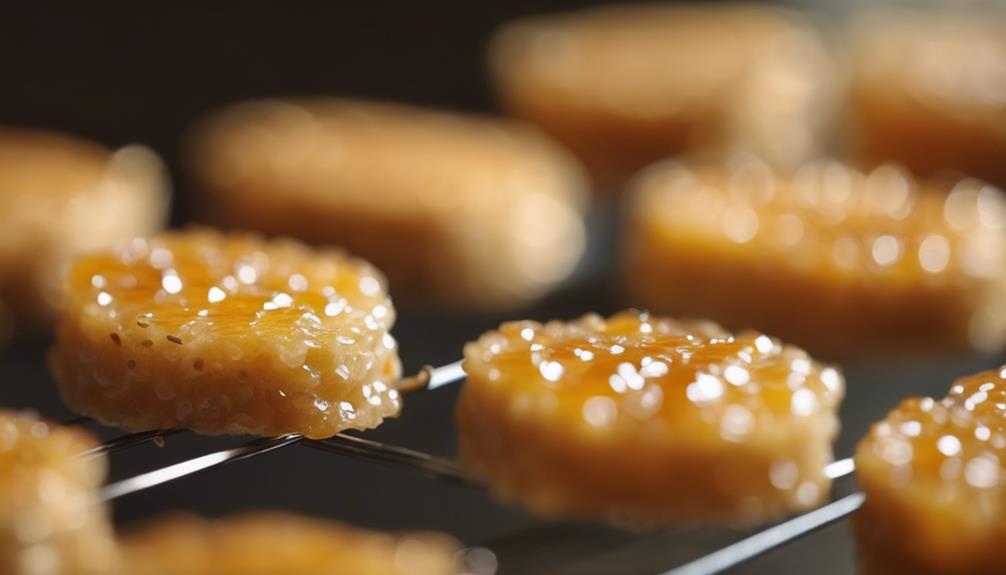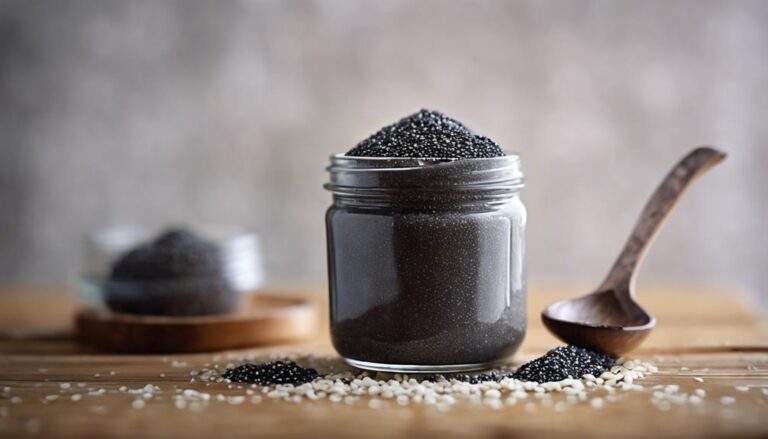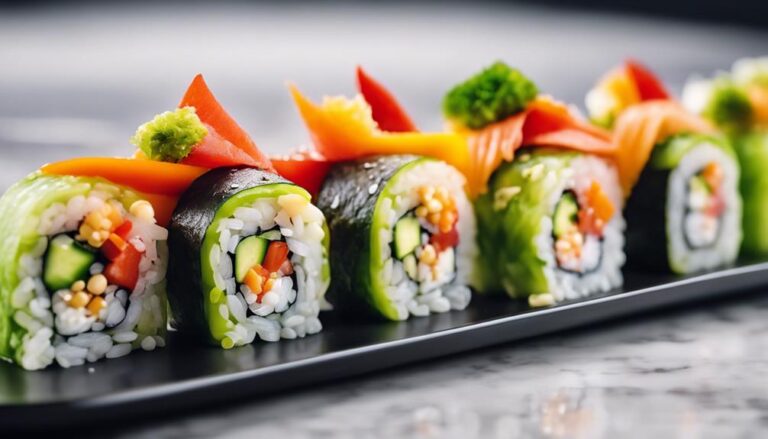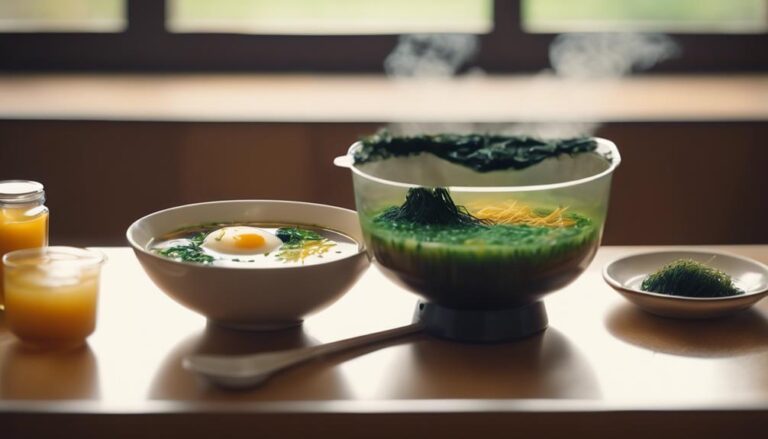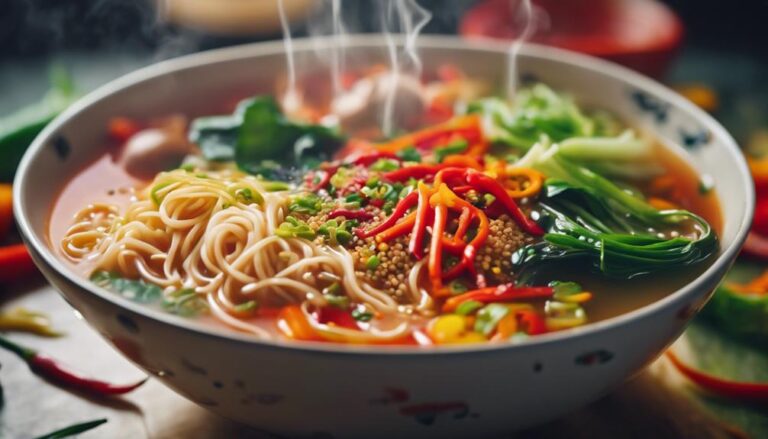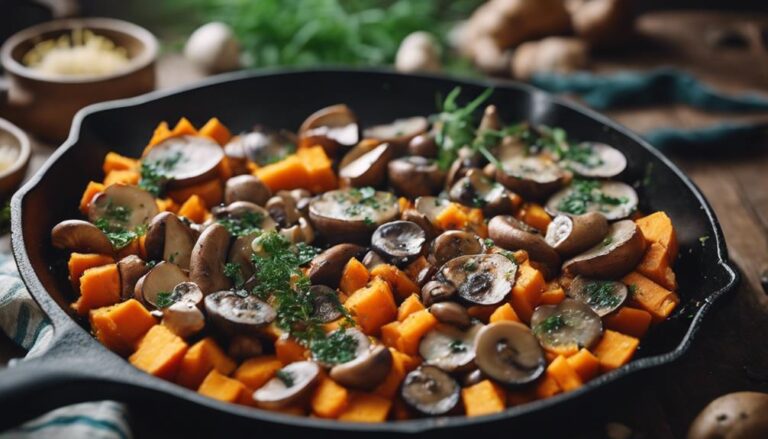Sous Vide Sesame and Honey Rice Cakes: A Sweet Snack Treat
Explore a delightful fusion of nutty sesame seeds and honey sweetness in our sous vide sesame and honey rice cakes. These savory treats offer a unique dessert option that can be customized with various toppings like fresh fruits or chocolate drizzles. Adjust the sweetness level to suit your taste by changing the honey amount. These rice cakes promise to leave a lasting impact on your taste buds, so get ready to savor the exquisite flavors that await.
What You Will Learn Here
- Sous vide method ensures precise cooking for perfect texture and flavor.
- Nutty sesame seeds complement sweet honey, creating a delightful taste.
- Customizable sweetness level by adjusting honey quantity to suit preferences.
- Versatile for serving with fruits, chocolate, or whipped cream for variety.
- Offers a unique sweet snack treat with a lasting impact on taste buds.
Origins of Rice Cakes

The origins of rice cakes date back centuries and are rooted in various cultures worldwide.
These traditional treats have been prepared in countless ways, each recipe reflecting the unique culinary practices of different regions.
Beyond their delicious taste, rice cakes hold significant cultural importance, often being used in celebrations and rituals to symbolize prosperity and good fortune.
Historical Rice Cake Origins
Dating back centuries, the origins of rice cakes can be traced to various Asian cultures where rice was a staple food. In Asian celebrations, rice cakes have long been a symbol of prosperity and good fortune. These festive treats hold a special place in the hearts of many communities, often prepared during important occasions such as weddings, New Year festivities, and religious ceremonies.
The tradition of making rice cakes dates back to ancient times when rice was abundant and revered for its versatility. Different regions in Asia developed their unique variations of rice cakes, each with its own special ingredients and methods of preparation. The significance of rice cakes extended beyond mere sustenance; they were seen as offerings to deities, tokens of gratitude, and symbols of unity within families.
Through generations, the art of making rice cakes has been passed down, preserving cultural heritage and culinary craftsmanship. Today, rice cakes continue to be an integral part of Asian cuisine, embodying the rich history and traditions of the diverse cultures that cherish them.
Traditional Rice Cake Recipes
Explore the diverse array of traditional rice cake recipes that have evolved over centuries in various Asian cultures. Rice cake desserts come in a wide range of flavors and textures, from the chewy Korean tteok to the sweet Filipino bibingka. These desserts are often made with glutinous rice flour, sugar, and coconut milk, creating a delightful treat for any occasion.
Modern variations include toppings like sesame seeds, red bean paste, or even fresh fruit to add a contemporary twist to these classic recipes.
On the savory side, rice cakes are commonly enjoyed as a delicious snack or side dish. In Korean cuisine, tteokbokki features rice cakes stir-fried with spicy gochujang sauce and vegetables, offering a perfect balance of sweet and spicy flavors. Pairing rice cakes with ingredients like mushrooms, soy sauce, or pork creates a savory dish that's both comforting and satisfying.
Traditional rice cake recipes have truly stood the test of time, continuing to be cherished and enjoyed by people around the world.
Cultural Significance of Rice Cakes
Ever wondered about the cultural roots and significance of rice cakes in various Asian traditions? Rice cakes hold deep cultural importance, often being central to festive celebrations and symbolic rituals. In Asian cultures, these cakes symbolize unity, prosperity, and family bonds. They're commonly shared during special occasions and ceremonies as a way of bringing people together and honoring traditions.
Family recipes for rice cakes have been passed down through generations, each with its unique twists and variations. While traditional recipes are cherished, many modern adaptations have emerged, incorporating new flavors and techniques to cater to evolving tastes. These modern twists on rice cakes continue to preserve the essence of the dish while offering a fresh take on a beloved classic.
Whether enjoyed during Lunar New Year celebrations, weddings, or family gatherings, rice cakes remain a staple in Asian cuisine, embodying cultural heritage and culinary creativity. The enduring significance of rice cakes reflects the enduring traditions and values that bring communities together in shared joy and appreciation.
Key Rice Cake Components
To create delicious rice cakes, you need to carefully consider the essential components that form the base of this delectable treat. Here are three key elements to keep in mind:
- Cooking Methods and Ingredient Options:
The cooking method you choose, whether it's traditional steaming, baking, or the modern sous vide technique, greatly impacts the final texture and flavor of your rice cakes. Additionally, ingredient options play a pivotal role. From sticky rice to glutinous rice flour, the type of rice used and other ingredients like coconut milk, sugar, or honey can elevate the taste and consistency of your rice cakes.
- Texture Preferences and Flavor Combinations:
Texture preferences vary among individuals; some enjoy a chewier consistency, while others prefer a softer bite. Experimenting with different ratios of rice to liquid and adjusting cooking times can help achieve the desired texture. When it comes to flavor combinations, the possibilities are endless. Whether you opt for classic pairings like sesame and honey or more adventurous flavors like matcha and red bean, finding the perfect balance is key to creating a memorable rice cake experience.
Tasty Rice Cake Variations

When it comes to tasty rice cake variations, sweet sesame rice cakes are a delightful option to try.
These rice cakes are infused with the rich flavors of sesame and honey, creating a delicious treat that balances sweetness with nuttiness.
The combination of sesame seeds and honey adds a unique twist to traditional rice cakes, making them a flavorful and satisfying snack or dessert option.
Sweet Sesame Rice Cakes
Enhance your rice cake repertoire with delectable sweet sesame variations that will tantalize your taste buds. These sweet sesame rice cakes are perfect for snack time or as sweet treats throughout the day.
Here are three delightful variations to try:
- Classic Sweet Sesame: Combine cooked rice with a mixture of honey, sesame seeds, and a touch of vanilla extract. Form the mixture into small cakes and pan-fry them until golden brown for a crispy exterior and a chewy center.
- Sesame and Coconut Bliss: Add shredded coconut to your sweet sesame rice cake mixture for a tropical twist. The combination of nutty sesame seeds and sweet coconut will transport you to a paradise of flavors with every bite.
- Choco-Sesame Indulgence: For a decadent treat, mix in some cocoa powder to your sweet sesame rice cakes. The rich chocolate flavor pairs beautifully with the nuttiness of the sesame seeds, creating a luxurious snack that will satisfy your sweet cravings.
Enjoy these delightful variations of sweet sesame rice cakes to elevate your snacking experience!
Enhancing Rice Cake Flavors
To enhance the flavors of your rice cakes, consider utilizing flavor infusion techniques like marinating the rice in a fragrant broth before cooking.
Experiment with ingredient pairings such as pairing sweet rice cakes with savory toppings like grilled vegetables or spicy sauces.
When taste testing your creations, pay attention to the balance of flavors and textures to guarantee a delightful eating experience.
Flavor Infusion Techniques
Explore various methods to infuse flavors into your rice cakes, elevating their taste profile to new heights. For a fruity twist, consider incorporating fruit infusion by adding pureed strawberries or mashed bananas into the rice cake mixture. These fruits won't only add a natural sweetness but also a burst of freshness that complements the rice cakes perfectly.
On the other hand, herb infusion can bring a savory and aromatic element to your rice cakes. Try steeping herbs like rosemary, thyme, or basil in warm milk before mixing it into the rice cake batter. The subtle herbaceous notes will add depth and complexity to the flavor profile, making each bite a delightful experience.
Experiment with different combinations of fruit and herb infusions to create unique and tantalizing rice cake flavors that will impress your guests. Whether you prefer a fruity sweetness or a savory herbaceous taste, these infusion techniques will take your rice cakes to the next level, making them a standout treat for any occasion.
Ingredient Pairing Ideas
Consider combining unexpected ingredients like matcha powder and coconut milk to create a unique and vibrant flavor profile for your rice cakes.
Experiment with flavor combinations such as cinnamon and orange zest to add a warm and citrusy touch to your treats.
For an elegant presentation idea, top your rice cakes with edible flowers or a sprinkle of edible gold dust to elevate the visual appeal.
When it comes to texture contrasts, try incorporating crunchy elements like chopped nuts or toasted sesame seeds into your rice cake mixture for a delightful crunch.
Additionally, explore cooking methods like pan-frying the rice cakes after sous vide to achieve a crispy exterior while maintaining a soft interior.
Taste Testing Tips
Enhance the flavors of your rice cakes by sampling small portions at various stages of preparation to adjust seasoning and ingredient ratios accordingly.
When considering sweet vs. savory options, bear in mind that taste preferences vary among individuals. To cater to a wider audience, striking a balance between these contrasting flavors is crucial.
Start by tasting the rice cake batter before cooking to ensure it aligns with your desired sweetness level. Adjust the amount of honey or sugar based on your taste preferences.
Once the rice cakes are cooked, taste a small piece to evaluate the overall flavor profile. If you find the sweetness lacking, consider drizzling some honey over the top. On the other hand, if the savory elements are overpowering, sprinkle some salt or add a touch of soy sauce to enhance the umami taste.
Final Thoughts
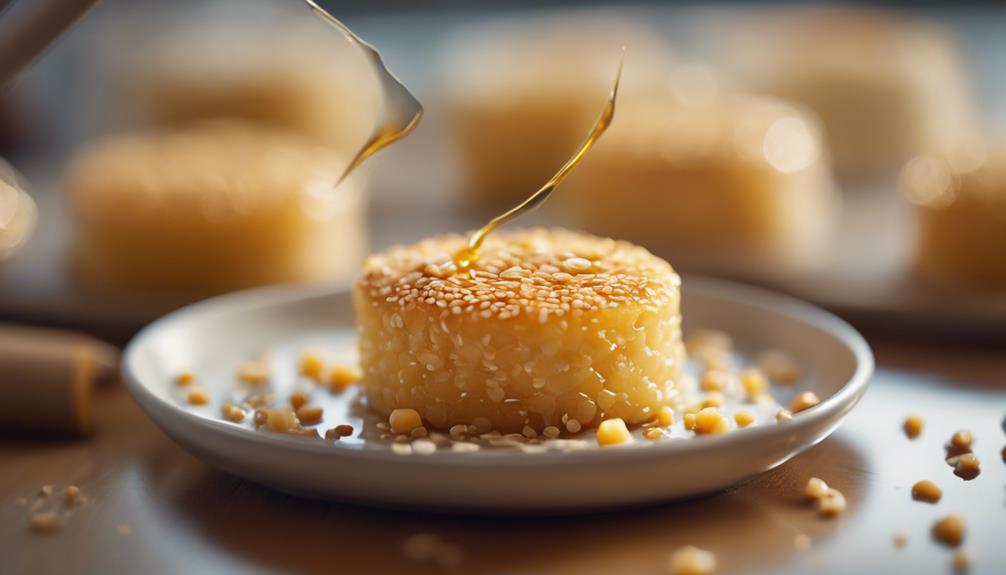
If you're looking to add a unique twist to your dessert repertoire, these Sous Vide Sesame and Honey Rice Cakes are a delightful option to contemplate. The overall impressions of this sweet treat are likely to leave a lasting impact on your taste buds.
The combination of the nutty sesame seeds, the sweetness of honey, and the comforting texture of the rice cakes creates a harmonious blend of flavors and textures that's hard to resist.
As you wrap up your culinary adventure with these rice cakes, consider the future possibilities that this recipe holds. Experimenting with different toppings such as fresh fruits, chocolate drizzles, or even a dollop of whipped cream can elevate these rice cakes to new heights.
Additionally, tweaking the sweetness level by adjusting the amount of honey used could cater to a variety of preferences.
Frequently Asked Questions
Can I Use a Regular Pot Instead of a Sous Vide Machine?
Yes, you can use a regular pot instead of a sous vide machine. However, keep in mind that a pot may lack precise temperature control and consistent water circulation, affecting the cooking method's accuracy and results.
How Long Do These Rice Cakes Stay Fresh For?
To keep your rice cakes fresh, store them in an airtight container or sealable bag. With proper packaging, these treats can stay delicious for up to five days. Follow these storing tips for the best shelf life.
Can I Substitute Sesame Seeds With Other Ingredients?
You can switch sesame seeds with flaxseeds, pumpkin seeds, chia seeds, or sunflower seeds for a unique twist. Experiment and find your favorite replacement to customize your rice cakes to suit your taste preferences.
Are These Rice Cakes Suitable for a Gluten-Free Diet?
Yes, these rice cakes are suitable for a gluten-free diet. They don't contain gluten ingredients. For those with allergies, always check labels. You can explore ingredient alternatives to customize the recipe to your dietary needs.
Can I Freeze These Rice Cakes for Later Consumption?
Yes, you can freeze these rice cakes for later enjoyment. To maintain freshness, wrap them individually before freezing. When ready to eat, simply thaw and reheat. Consider taste testing after freezing for best flavor.
Conclusion
To sum up, sous vide sesame and honey rice cakes offer a deliciously sweet snack treat that's easy to make and enjoyable to eat.
By combining traditional rice cake ingredients with flavorful additions, you can create a unique and tasty treat that's perfect for any occasion.
Experiment with different variations and flavors to find the perfect combination that suits your taste preferences.
So, go ahead and indulge in this delightful snack that's sure to satisfy your cravings.
